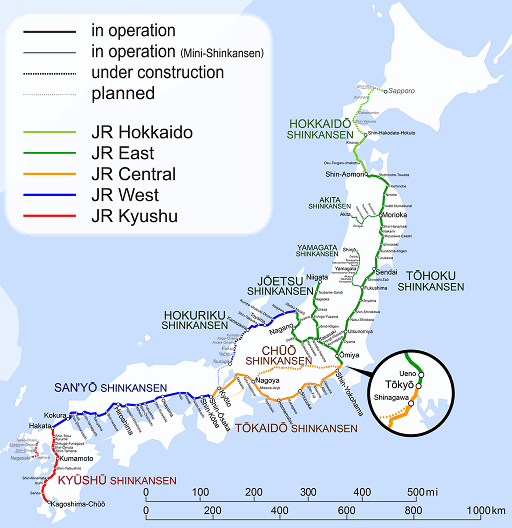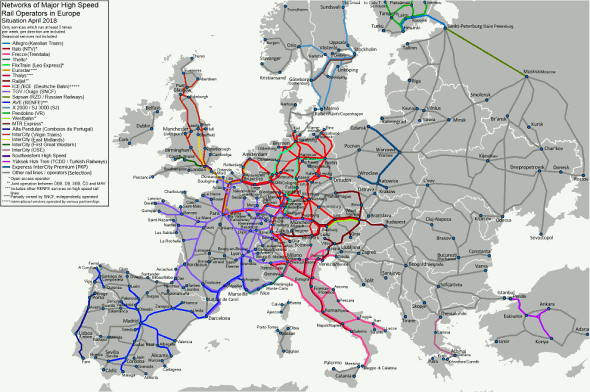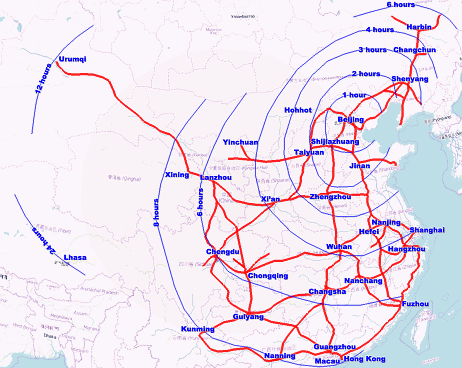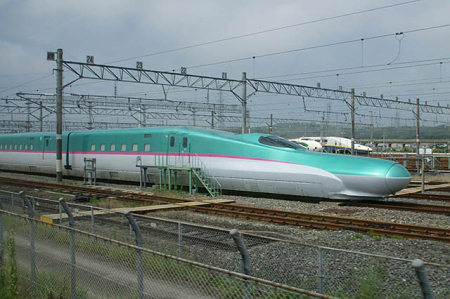Those who travel to other countries may experience high speed rail (HSR) services and wonder why a similar transportation network has not been implemented in the United States. The following fact sheet provides a brief history of international high-speed rail developments and a comparison of the status of HSR deployment around the world, along with a discussion of issues that policymakers and business leaders may want to consider in their long-term planning for future U.S. transportation infrastructure.
While there is no single international standard for high speed rail, new train lines having speeds in excess of 250 kilometers per hour (km/h), or 160 miles per hour (mph), and existing lines in excess of 200 km/h (120 mph) are generally considered to be high speed. Many countries in Europe and Asia have developed high-speed rail for passenger travel, although some systems also offer freight service.
Japan: The Birth of High-Speed Rail
The first high-speed rail system began operations in Japan in 1964, and is known as the Shinkansen, or “bullet train.” Today, Japan has a network of nine high speed rail lines serving 22 of its major cities, stretching across its three main islands, with three more lines in development. It is the busiest high-speed rail service in the world, carrying more than 420,000 passengers on a typical weekday. Its trains travel up to 320 km/h (200 mph), and the railway boasts that, in over 50 years of operation, there have been no passenger fatalities or injuries due to accidents.
|
Japan’s E5 Series Shinkansen (pictured above in its
pre-production version) has been in operation since 2011 on
the Tohoku line, and since 2016 on the Hokkaido line. Its
maximum service speed is 200 mph. |
 |
Europe: An International High-Speed Network
The next country to make high-speed rail available to the public was France in 1981, with service at 200 km/h (124 mph) between Paris and Lyon. Today, the French high-speed rail network comprises over 2,800 km of Lignes à grande vitesse (LGV), which allows speeds of up to 320 km/h or 200 mph, on which its TGVs (Trains à grande vitesse) run. This inter-city high-speed rail service is operated by SNCF, France’s national rail operator. Germany began operation of its Inter-City Express (ICE) high-speed trains through several German cities in 1991. The Eurostar service, connecting Paris to London via the Channel Tunnel, began operation in 1994. Due to France’s early adoption of high-speed rail and its central position between the Iberian Peninsula, the British Isles and Central Europe, most other high-speed rail lines in Europe have been built to the French standards for speeds, voltage and signaling, with the exception of Germany, which built to existing German railway standards.
Over the ensuing years, several European countries have built extensive high-speed rail networks that include several cross-border international links. Tracks are continuously being built and upgraded to international standards, expanding the network. International links between Italy and France, with connections to Switzerland, Austria and Slovenia, are underway. These links all incorporate extensive new tunneling under the Alps. European Union funding was approved in 2015 for the Turin–Lyon high-speed railway (at a cost of €25 billion), which will connect the French and Italian networks, and provide a link with Slovenia.
 |
| Credit: Bernese media |
In 2007, a consortium of European railway operators, Railteam, was
formed to coordinate and promote cross-border high-speed rail travel.
Developing a trans-European high-speed rail network is a stated goal of
the European Union, and most cross-border railway lines receive EU
funding.
China: Surpassing the Rest of the World
Due to generous funding from the Chinese government, high-speed rail in China has developed rapidly over the past 15 years. China began planning for its current high-speed rail system in the early 1990s, modeling it after Japan’s Shinkansen system. Chinese high-speed rail service began operation in 2008, running at speeds from 250 km/h to 350 km/h (217 mph) and traveling from Beijing to Tianjin (117 km or 73 miles). China’s HSR network is expected to reach over 38,000 km by 2025, and 45,000 km in the longer term, far more rail lines than in the rest of the world combined. China has imported most of its HSR systems through joint ventures with Japan, Germany, France, and other countries. But in recent years, China has been developing an internal production capability, and is now winning contracts for HSR development in other countries.
 |
|
Credit: Yaohua2000 |
After building high-speed rail on conventional tracks, in 2006 China began increasing its budget to build dedicated high-speed rail lines (from $14 billion in 2004 to $88 billion in 2009). Overall, China has dedicated $300 billion to build a 25,000 km HSR network by 2020. Most of the new lines follow the routes of existing trunk lines and are designated for passenger travel only. Several sections of the national grid link cities that had no previous rail connections and will carry a mix of passenger and freight. High-speed trains can generally reach 300–350 km/h (190–220 mph). On mixed-use HSR lines, passenger train service can attain peak speeds of 200–250 km/h (120–160 mph).
China’s most profitable high-speed rail line, reporting 6.6 billion yuan (over $1 billion) in net operational profit in 2015, connects Beijing to Shanghai, two major economic zones. Construction first started on this 1,318 km-line in 2008, and it opened for commercial service in 2011.
Critics both in China and abroad have questioned the necessity of having an expensive high-speed rail system in a largely developing country, where most workers cannot afford to pay a premium for faster travel. In response, the Chinese government argues that high-speed rail:
- Provides a fast, reliable and comfortable means of transporting large numbers of travelers in a densely populated country over long distances and improves economic productivity and competitiveness in the long run by linking labor markets and freeing up older railways to carry freight.
- Stimulated the economy in the short term by creating construction jobs and helping drive demand for construction, steel and cement during the economic downturn in 2008-2009.
- Facilitates cross-city economic integration and promotes the growth of smaller cities by connecting them with larger cities.
- Supports energy independence and environmental sustainability, as electric trains use less energy to transport people and goods on a per unit basis and can draw power from more diverse sources of energy (including renewables) than automobiles and aircraft.
- Fosters an indigenous HSR technology and components industry; Chinese train equipment manufacturers have quickly absorbed foreign technologies (such as Japan’s Shinkansen systems), localized production processes, and begun competing with foreign suppliers in the export market.
The growth of HSR in China has forced domestic airlines to cut airfares and cancel regional flights, especially for flights under 500 km, and some of the shorter inter-city routes were completely terminated. China’s high-speed rail now carries more than twice as many passengers as its domestic airlines.
United States: Lagging Behind but Catching Up?
In the United States, there is not yet a fully high-speed train line, and none are being built except in California. The Acela Express, running between New York and Washington D.C., reaches a top speed of 150mph on limited portions of its route, but its average speed is only about 66 mph. California is in the process of building an HSR system, but the first phase, connecting San Francisco to Los Angeles and Anaheim, is not expected to be completed until 2029 (although some of the infrastructure is already being used). No other state or local jurisdiction has, at this time, allocated the funding to begin construction of high-speed rail. In Texas, studies are being conducted for a “Bullet Train” between Dallas and Houston, and advocates say that construction should begin in a year or so. In Florida, the Brightline service between Miami and Orlando is operational, but with an average speed of 80 mph, it does not meet the minimum speeds to be considered HSR (although plans for increased speeds are underway). In addition, Florida’s governor recently announced another potential HSR line between Orlando and Tampa.
Several reasons can be listed for this disparity between U.S. and foreign HSR developments:
- the lower population density of U.S. cities compared to those in Europe and Asia makes it difficult to give high-speed rail large enough numbers of people to make it economically viable;
- stronger property rights in the United States compared to other countries, which make it difficult for governments to purchase land for new railroads;
- America’s car culture and emphasis on driving (total automotive marketing spending in the United States is about $35 billion per year and climbing);
- the difficulty of shifting to public transit once city/county infrastructure has already been built and been designed for automobile accessibility rather than train stations;
- U.S. long distance railways are mostly owned by freight companies, forcing passenger rail carriers to yield priority to freight trains;
- the greater distance between many U.S. cities allows many transportation needs to be more conveniently served by commercial airlines; and
- political interference by some extremely wealthy individuals who want to suppress interest in railroads to maximize fossil fuel use.
High-Speed Rail by Country
The table below compares countries/economies according to their level of deployment of HSR railways, in order from most development to least, based on data from the International Union of Railways (UIC) and from other sources that provide updated data. A number of other countries are listed as having long-term planning for HSR, but no funding has been allocated to their programs to date. In addition, other sources indicate that some countries have HSR systems in place even though UIC has indicated that they do not.
|
Country |
Length of lines in operation (km) |
Lines under construction (km) |
Approved but not started construction |
Max speed (km/h) |
|
China |
26,869 |
10,738 |
1,268 |
350 |
|
Spain |
3,100 |
1,800 |
0 |
310 |
|
Japan |
3,041 |
402 |
194 |
320 |
|
France |
3,220 |
125 |
0 |
320 |
|
Germany |
3,038 |
330 |
0 |
300 |
|
Sweden |
1,706 |
11 |
0 |
205 |
|
United Kingdom |
1,377 |
230 |
320 |
300 |
|
South Korea |
1,104 |
376 |
49 |
305 |
|
Italy |
999 |
116 |
0 |
300 |
|
Turkey |
802 |
1,208 |
1,127 |
300 |
|
Russia |
845 |
0 |
770 |
205 |
|
Finland |
609 |
0 |
0 |
220 |
|
Uzbekistan |
600 |
0 |
0 |
250 |
|
Austria |
352 |
208 |
0 |
250 |
|
Taiwan-China |
354 |
0 |
0 |
300 |
|
Belgium |
326 |
0 |
0 |
300 |
|
Poland |
224 |
0 |
484 |
200 |
|
Netherlands |
175 |
0 |
0 |
300 |
|
Switzerland |
144 |
15 |
0 |
250 |
|
Luxembourg |
142 |
0 |
0 |
320 |
|
Norway |
64 |
54 |
0 |
210 |
|
U.S.A. |
54 |
192 |
1,710 |
240 |
|
Saudi Arabia |
0 |
453 |
0 |
300 |
|
Denmark |
0 |
56 |
0 |
200 |
|
Thailand |
0 |
0 |
615 |
300 |
|
Sweden |
0 |
11 |
0 |
205 |
|
Russia |
0 |
0 |
770 |
250 |
|
Iran |
0 |
0 |
1,351 |
300 |
|
Indonesia |
0 |
0 |
712 |
250 |
|
India |
0 |
0 |
508 |
250 |
|
Malaysia/Singapore |
0 |
0 |
350 |
250 |
|
Israel |
0 |
0 |
85 |
250 |
|
Portugal |
0 |
0 |
550 |
250 |
|
Czech Republic |
0 |
0 |
660 |
250 |
|
Greece |
0 |
500 |
200 |
250 |
|
Hungary-Romania |
0 |
0 |
460 |
250 |
Long-term Prospects for High-Speed Rail
Economic Viability. Analysts have suggested that some countries may have over-extended their HSR networks, claiming that revenues and profit margins have fallen, and cheap flights and car-sharing services may draw some customers away from rail options. The facts, however, seem to belie these warnings. In China, HSR lines have proven their profitability, and throughout Asia and Europe, HSR is providing a lower cost and shorter travel time alternative to air travel for many of the shorter routes. Advocates argue that by increasing the number of cities that have HSR hubs, the network effect will geometrically multiply the utility of HSR to travelers, and hence will provide long-term economic and lifestyle benefits for all citizens.
It is not clear whether developing HSR between some U.S. cities would
stimulate their economies enough to make it sustainable in the long
term. The HSR deployments in California will be watched closely by
government and business leaders in other U.S. regions, who may make
their financing decisions based on the perceived degree of success of
California’s HSR. Despite the increases in projected costs, support for
high-speed rail among Californians remains high.
Competition with other
technologies. Technologies
such as magnetic levitation (maglev) and hyperloop are promising ever
faster rail speeds. Maglev is already a proven technology: since 2004,
for example, China has operated a maglev train between Shanghai and
Pudong International Airport, which can travel up to 430 km/h (270 mph).
The line covers 30 km (19 miles) in seven minutes. China is currently
one of only three countries (along with Japan and South Korea) that
operate a maglev train. Hyperloop systems, which involve propelling
trains through sealed tubes that have been emptied of as much air as
possible to reduce air resistance, are still on the drawing board.
Maglev and hyperloop systems both require the construction of all new rail lines, which calls into question further investment in more conventional HSR technologies. Nevertheless, advocates point out that HSR is a mature technology, unlike these other rail transport schemes, and so is a much lower risk investment for governments and urban planners. Both maglev and hyperloop are very costly, and pose potential health and safety risks that conventional HSR does not.
 |
|
Credit: US High Speed Rail Association |
HSR advocates further argue that the throughput (in terms of numbers of people moved from place to place for a given investment) provided by high-speed rail far outpaces those provided by highways or airports. In the chart to the left, the US High Speed Rail Association depicts how high-speed rail offers significant time savings compared with flying or driving between downtown San Francisco and downtown Los Angeles in California.
Transportation
benefits. Many would argue that economic development should not
be the main measure of a transportation system, but that its ability to
move people and goods should be the primary consideration. That is how
highway and airport projects are evaluated. Every country that builds
HSR does so for the high capacity, sustainable mobility it delivers,
first and foremost, with economic development and better safety as
beneficial side effects.
Energy savings. Reducing
the number of cars on roads and highways translates into big energy
savings and a reduced demand for oil. According to International Union
of Railways (UIC) data, high-speed rail is more than four times as
energy efficient as driving in cars and nearly nine times more efficient
than flying.
Environmental considerations. High-speed rail clearly offers a path
to lower greenhouse gas emissions than other modes of transportation. If
HSR services can entice people out of their cars by offering convenience
and speed at a low cost, this would significantly reduce societal energy
consumption and carbon emissions. The California High-Speed Rail
Authority (CHSRA), for example, estimates that by 2040, California’s HSR
system will reduce vehicle miles of travel in the state by 10 million
miles each day; over a 58-year period, the system will reduce auto
traffic on the state’s highways by over 400 billion miles of travel. In
addition, CHSRA estimates that starting in 2030, the state will see a
reduction of 93 to 171 flights daily, which translates into improved air
quality and improved health, along with the economic benefits of a more
energy-efficient transportation system.
In many countries, laws and policies are already in place requiring businesses and consumers to reduce their emissions, and a consensus toward those trends is emerging over time. High-speed rail can offer the triple bottom line (economic, social and environmental sustainability) that many policymakers have called for over the years.
Author: Richard Nunno Editor: Carol Werner
